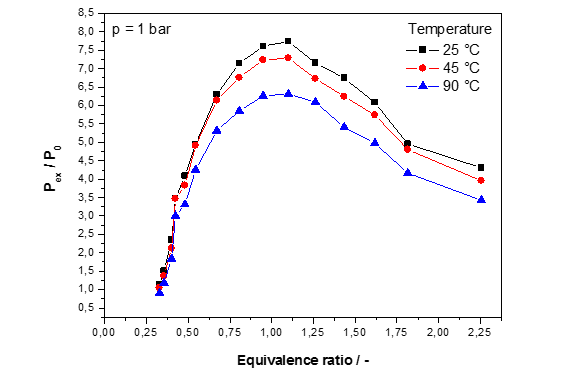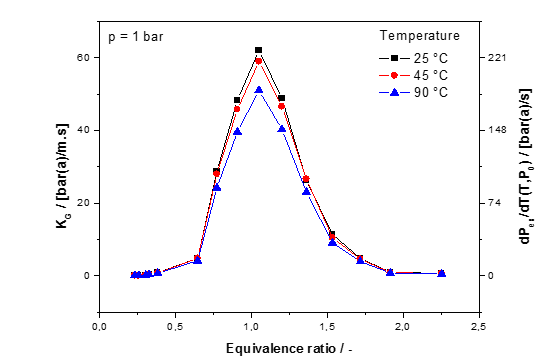Explosion parameters of mixtures: coal gas - air
Výbuchové parametry směsí: koksárenský plyn - vzduch
Jan Skřínský
Výzkumné energetické centrum, VŠB-TU Ostrava, 17. Listopadu 15/2172, 708 33 Ostrava, Česká republika; tel. +420 597 324 931, e-mail: jan.skrinsky@vsb.cz
Abstract
The values of the coal gas explosion parameters are currently published in the form of the calculations of pure components under standard "atmospheric" conditions. No explosion characteristics of the H2-CH4-CO-C3H8-CO2-N2 and air mixtures measured in 0.02 m3 explosion autoclave have been reported in the literature. The information in the material safety data sheets are given for such complex mixtures using modified Le Chatelier equations. The maximum explosion pressure, pmax, the maximum rate of explosion pressure rise, (dp/dt)max, the deflagration index, KG, lower explosion limit, LEL, upper explosion limit, UEL and limiting oxygen concentration, LOC of coal gas with air mixture at initial temperatures 25 °C, 45 °C, 90 ° C and initial pressure 1 bar, are presented in this paper.
Keywords: 0.02 m3 autoclave; ethanol; maximum explosion pressure; maximum rate of pressure rise; deflagration index; lower explosion limit; upper explosion limit; limiting oxygen concentration
Abstrakt
Hodnoty výbuchových parametrů koksárenského plynu jsou v současnosti publikovány ve formě výpočtů ze složek čistých látek, za standardních „atmosférických“ podmínek. V literatuře nejsou uvedeny žádné hodnoty výbuchových charakteristik směsí H2-CH4-CO-C3H8-CO2-N2 a vzduchu změřené v 0,02 m3 výbuchovém autoklávu. Informace v bezpečnostních listech jsou pro takto komplexní směsi uváděny jako výsledek odhadu pomocí modifikovaných Le Chatelierových rovnic. V tomto článku jsou prezentovány maximální výbuchový tlak, pmax, maximální rychlost nárůstu výbuchového tlaku, (dp/dt)max, deflagrační index, KG, spodní mez výbušnosti, LEL, horní mez výbušnosti, UEL a limitní koncentrace kyslíku, LOC směsi koksárenského plynu se vzduchem při počátečních teplotách 25 °C, 45 °C, 90 ° C a počátečním tlaku 1 bar.
Klíčová slova: 0,02 m3 autokláv; etanol; maximální výbuchový tlak; rychlost nárůstu výbuchového tlaku; deflagrační index; spodní mez výbušnosti; horní mez výbušnosti; limitní koncentrace kyslíku
1. Introduction
1.1 Energy industry
There are three commonly used gas fuels: natural gas (NG), liquefied petroleum gas (LPG) and coal gas (CG). Among them, coal gas not only greatly improves the utilization ratio of coal energy (up to 60%), but also significantly reduces the environmental pollution that is otherwise caused by coal combustion. In addition, coke and other various chemical products can concurrently be extracted as the by-products during the preparation of coal gas.
1.2 Safety
Explosion parameters of individual gases at ambient temperature and atmospheric pressure have been studied systematically. But only limited data are available for such multicomponent mixed gas as coal gas. In particular, to the best of author’s knowledge, there is basically no substantial understanding on the explosion characteristics of coal gas at elevated temperatures and pressures till now. Therefore, research on explosion limits of coal gas is of great importance to ensure the safety in industrial and domestic applications that produce or use coal gas.
2. Experiment
2.1 Experimental device
Measurements have been performed in the 0.02 m3 explosion chambers (OZM Research s.r.o., Czech Republic). The experimental set-up used has been described in detail previously [1]. Fig. 1 described how was adapted for the measurement of the coal gas.
![0.02 m3 vessel experimental arrangement [1]](/sites/default/files/obsah/josra/explosion-parameters-mixtures-coal-gas-air/obrazky/coal-gas01.gif)
Figure 1: 0.02 m3 vessel experimental arrangement [1]
2.2 Experimental procedures
The general experimental procedure was as follows: (a) the air in the explosion vessel was evacuated to a vacuum of 0.1-0.4 bar; (b) gases were added into the vessel at different ratios; (c) the mixture was admitted at the desired pressure, then ignited at once; (d) after ignition and the capture of the signals by the acquisition system, the burned gas was completely evacuated. Then, a new cycle was repeated. The more detail experimental procedures are described in [2-4].
2.3 Coal gas used in the experiment
The compositions of coal gas for the experiments are taken from the month averages of real coal gas concentration from industrial by-product of coal carbonization. The composition in Tab. 1 has been used to prepare the gas mixture sample for 0.02 m3 experiments (Certified composition by Siad s.r.o.). The reported uncertainties of the ingredients in Tab. 1 are based on the standard uncertainties multiplied by a coverage factor k=2, providing the level of confidence of approximately 95 %.
| Ingredients | Content vol. % |
|---|---|
| H2 | 52.2±0.5 |
| CH4 | 22.4±0.3 |
| CO | 6.8±0.18 |
| C3H8 | 3.8±0.01 |
| CO2 | 2.8±0.02 |
| N2 | 12.0±0.2 |
Table 1: Composition of Coal gas used in the experiment
3. Results
The results of explosion characteristics of coal gas/air mixture studied systematically under atmospheric pressure and various temperatures in a constant volume explosion chamber are in Fig. 2-4.
Fig. 2 illustrates the real non-adiabatic explosion. The red and orange spots in the Fig. 2 illustrates the soot that have been produced during the first phase (i.e. in the first 10 ms) of the explosion.

Figure 2: High-speed images illustrating the evolution of coal gas spherical flames
Fig. 3 illustrates the normalized peak explosion pressure (Pex/P0) versus equivalence ratios at atmospheric pressure and three initial temperatures. The maximum explosion pressure, pmax, was determined as the highest pex found for the mixture compositions investigated (Tab. 1).

Figure 3: Normalized peak explosion pressure, Pex/P0, versus equivalence ratio
Fig. 4 shows the comparison among rate of pressure rise, (dP/dt)ex , and deflagration index, KG, versus equivalence ratio at elevated temperatures and atmospheric pressure for the coal gas/air mixtures. Maximum rate of pressure rise and deflagration index reach their peaks at Ф around 1.14, and they decrease at both lean and rich mixtures. Rate of pressure rise is affected by both flame speed and heat release. Flame speed increases monotonically with the increase of temperature, but the decrease of total fuel mass results in the decreased heat release and offsets the effect of flame speed on the explosion pressure.

Figure 4: Rate of pressure rise, (dP/dt)ex, and deflagration index, KG
4. Conclusion
Explosion parameter data are essential for a quantitative risk assessment of explosion hazard associated with the use of coal gas. The present work is to investigate the influence of various initial temperatures on explosion characteristics of coal gas/air mixture. The comparison of the values against the different initial temperatures is listed in Tab. 2. Uncertainties in Tab. 2 are given by the standard method used [2-4].
| Charakteristic | T0 = 25 °C | T0 = 45 °C | T0 = 90 °C |
|---|---|---|---|
| Ф (vol. %) | 1.1 | 1.1 | 1.1 |
| pmax/p0 (bar) | 7.8±0.8 | 7.3±0.7 | 6.3±0.6 |
| tPmax(ms) | 15 | 15 | 16 |
| (dp/dt)max (bar/s) | 229±23 | 214±21 | 185±19 |
| KG (bar·m/s) | 62±6.2 | 58±5.8 | 50±5.0 |
| LEL (obj. %) | 5.5-0,2 | 5.0-0,2 | 4.5-0,2 |
| UEL (obj. %) | 35.0+0,2 | 36.0+0,2 | 37.5+0,2 |
| LOC / N2 (obj. %) | 8.0±0,2 | 8.0±0,2 | 7.5±0,2 |
Table 2: Explosion parameters for atmospheric conditions
Acknowledgement
This work would not have been possible without the financial support of Innovation for Efficiency and Environment - Growth, reg. no. LO1403 supported by National Programme for Sustainability and financed by the Ministry of Education, Youth and Sports. J.S. is thankful to FBI, VŠB-TU Ostrava for high-speed images illustrating the evolution of expanding coal gas spherical flames and preparing of the gas mixture.
References
[1] SKŘÍNSKÝ, Jan. Výbuchové parametry směsí: etanol-etylacetát-vzduch. Časopis výzkumu a aplikací v profesionální bezpečnosti [online]. 2017, roč. 10, č. 1. Dostupný z: http://www.bozpinfo.cz/josra/vybuchove-parametry-smesi-etanol-etylacetat-vzduch. ISSN 1803-3687.
[2] EN 15967:2012. Determination of maximum explosion pressure and the maximum rate of pressure rise of gases and vapours. Berlin: Beuth Verlag, 2012.
[3] EN 1839:2013. Determination of explosion limits of gases and vapors. Berlin: Beuth Verlag, 2013.
[4] EN 14756:2007. Determination of the limiting oxygen concentration for flammable gases and vapors. Berlin: Beuth Verlag, 2007.
Article citation
SKŘÍNSKÝ, Jan. Explosion parameters of mixtures: coal gas - air. Časopis výzkumu a aplikací v profesionální bezpečnosti [online]. 2017, roč. 10, č. 3-4. Dostupný z: http://www.bozpinfo.cz/josra/explosion-parameters-mixtures-coal-gas-air. ISSN 1803-3687.
Užitečné odkazy
Provozovatel portálu
Jeruzalémská 1283/9
110 00 Praha 1


